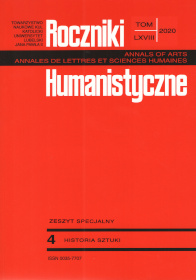The Apostolic Letter Duodecimum Saeculum of the Holy Father John Paul II on the Twelfth Centenary of the Second Council of Nicaea. The Meaning of the Icon in the Faith and Understanding of John Paul II
Abstract
The letter of the Holy Father John Paul II written in Rome in 1987, in the tenth year of His pontificate, on December 4th, on the day of memorial of Saint John Damascene, the doctor of the Church, on the Twelfth Centenary of finishing the controversy over the icon, is of great importance for the Pope’s program of ecumenism. The Holy Father indicated various directions of the dialogue, however, the one of the utmost importance concerned the agreement with the Orthodox Church, which was confirmed in the letters and in His other documents quoted in this paper. The image used to be essential for religious practice, for illustrating the word of prayer and of the song, in order to preserve the tradition of the Church. The strict prohibition introduced by the iconoclasm depreciated not only the artistic tradition of paintings but also the basic dogmas of Christ’s Incarnation and the one which introduced Virgin Mary as the Theotokos (the God-bearer). The ban constituted a threat not only for the icons but also for the Christian faith. In His Letter, the Pope underlined the important role of the Second Council of Nicaea which reintroduced icons and maintained and deepened the meaning of the cult in the faith of believers. Furthermore, the Holy Father indicated the connection with the Second Vatican Council in understanding the function and form of images in contemporary Church. Contemporary trends are overwhelmed by the impotence of the spiritual expression of sacral art, which is a great concern for the Pope. The Letter is, therefore, a dramatic warning of the threats for religious art in contemporary time, expressed by the Holy Father with these words: ‘The rediscovery of the Christian icon will also help in raising the awareness of the urgency of reacting against the depersonalizing and at times degrading effects of the many images that condition our lives in advertisements and the media.’ (DS, 11).
References
Alexander, Paul J. The Patriarch Nicephorus of Constantinople. Ecclesiastical Policy and Image Worship in the Byzantine Empire. Clarendon Press, 1958.
Alteri, Giovanni. «Immagini della storia sulle monete byzantine.» Splendori di Bisanzio. Testimonianze e riflessi d’arte e cultura bizantina nelle chiese d’Italia, Giovanni Morello Fabbri, 1990, ss. 71-83.
Belting, Hans. Obraz i kult. Historia obrazu przed epoką sztuki. Przeł. Tadeusz Zatorski, Wydawnictwo Słowo / Obraz Terytoria, 2010.
Brubaker, Leslie. Vision and Meaning in Ninth-Century Byzantium. Image as Exegesis in the Homilies of Gregory of Nazianzus. Cambridge University Press, 1998.
Brubaker, Leslie, and John F. Haldon. Byzantium in the Iconoclast Era (c. 680-850). The Sources. An Annotated Survey. Ashgate, 2001.
Büchsel, Martin, and Rebecca Müller. Intellektualisierung und Mystifizierung mittelalterlicher Kunst. „Kultbild“. Revision eines Begriffs. Mann 2010.
Culter, Anthony, and Jean-Michael Spieser, Byzance médiévale. 700-1204. Gallimard, 1996.
Dokumenty soborów powszechnych, oprac. Arkadiusz Baron i Henryk Pietras, przeł. Teresa Wnętrzak, Wydawnictwo WAM, 2001.
Grabar, André. Les voies de la création en iconographie chrétienne. Antiquité et moyen âge. Flammarion, 1994.
Grabar, André. L’iconoclasme byzantin. Le dossier archéologique. Flammarion, 1984.
Hryniewicz, Wacław, ks., Karol Karski, i ks. Henryk Paprocki. Credo. Symbol naszej wiary. Społeczny Instytut Wydawniczy Znak, 2009.
Jan Paweł II. Dzieła zebrane, t. 14: Homilie i przemówienia okolicznościowe. Wydawnictwo M, 2010. Jan Paweł II. „List apostolski «Duodecimum saeculum» z okazji 1200. rocznicy Soboru Nicejskiego II” Jan Paweł II. Dzieła, t. 3: Listy, t. 2, Wydawnictwo M, 2009, ss. 436-445.
Jan Paweł II. „List apostolski «A Concilio Constantinopolitano» z okazji 1600 rocznicy I Soboru Konstantynopolitańskiego i 1550 rocznicy Soboru Efeskiego”. Jan Paweł II. Dzieła, t. 3: Listy, Wydawnictwo M, 2009.
Konstytucja duszpasterska o Kościele w świecie współczesnym „Gaudium et spes”. Sobór Watykański II. Konstytucje. Dekrety. Deklaracje. Tekst Polski. Nowe Tłumaczenie, red. Maria Przybył, Pallottinum, 2002, s. 526-605.
Ratzinger, Josef. Der Geist der Liturgie. Eine Einführung. Herder, 2000, wyd. pol. Duch liturgii. Przeł. Eliza Pieciul, Wydawnictwo AA, 2005.
Rogozińska, Renata. „«Wyjdzie z zamętu świat ducha». Myśl estetyczna Jana Pawła II a sztuka współczesna”. Bo piękno na to jest, by zachwycało. Jan Paweł II w kulturze polskiej, red. Waldemar Chrostowski, Księgarnia św. Wojciecha, 2004, ss. 21-37.
Romano, Serena. «Rom und die Ikonen. Überlegungen zu Monument und Dokument im Mittelalter». Intellektualisierung und Mystifizierung mittelalterlicher Kunst. „Kultbild“. Revision eines Begriffs, hrsg. von Martin Büchsel, Rebecca Müller, Mann, 2010, z. 133-154.
Strzelczyk, Jerzy. Historia powszechna – średniowiecze. Wydawnictwo Poznańskie, 2008.
Świat Bizancjum, t. 2: Cesarstwo Bizantyńskie 641-1204, red. Jean-Claud Cheynet, przekł. Andrzej Graboń, Wydawnictwo WAM, 2011.
Wybór listów Ojca Świętego Jana Pawła II, red. Piotr Słabek, i Jacek Jękot, Wydawnictwo św. Stanisława B.M. Archidiecezji Krakowskiej, Wydawnictwo „M”, 1997.
Copyright (c) 2020 Roczniki Humanistyczne

This work is licensed under a Creative Commons Attribution-NonCommercial-NoDerivatives 4.0 International License.





